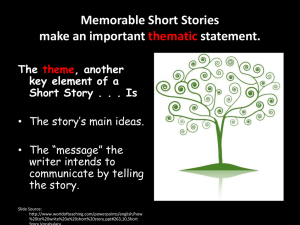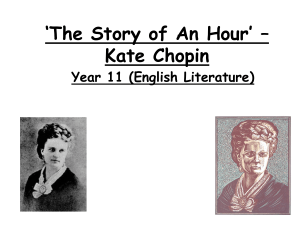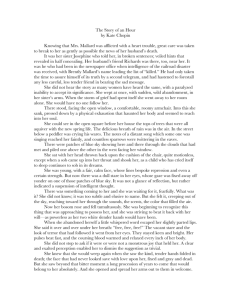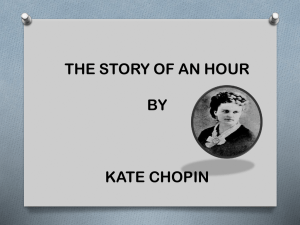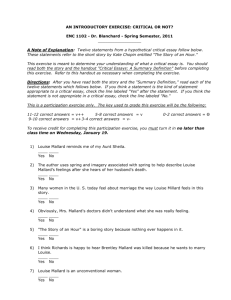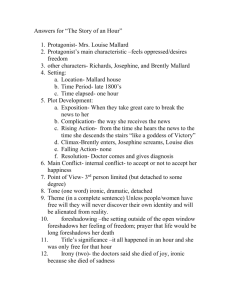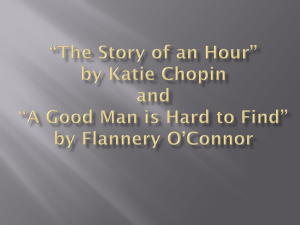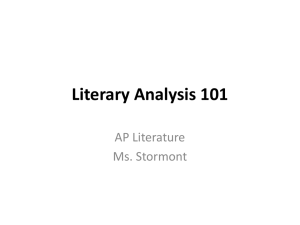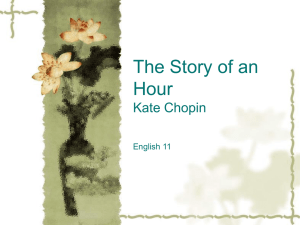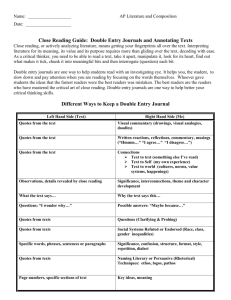How to Discuss A Short Story
advertisement
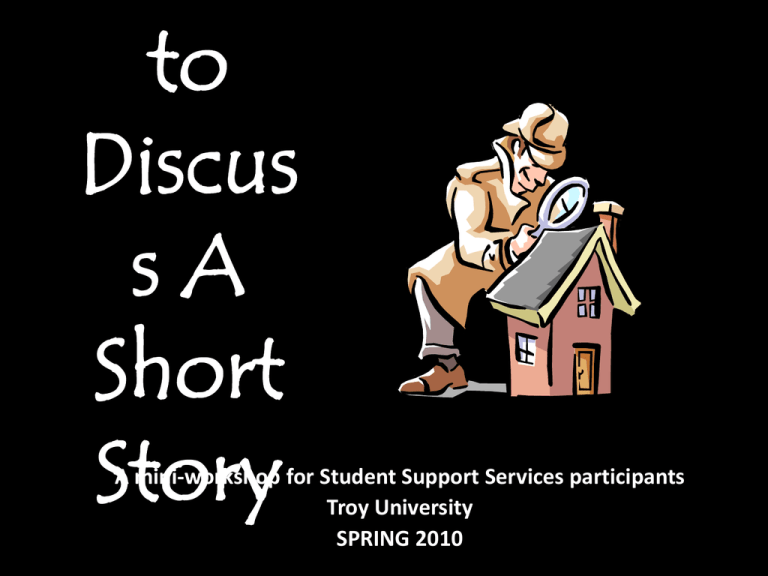
to Discus sA Short Story A mini-workshop for Student Support Services participants Troy University SPRING 2010 Short Story . . . What is it? Tells about a single event or experience Fictional (not true) 500 to 15,000 words in length Has a beginning, middle, and end Creates an impression on the reader Prose (Written in sentence and paragraph form, not in verse) Slide Source: http://www.worldofteaching.com/powerpoints/english/how%20to%20write%20a%20short%20story.ppt#257,2,Definition of a Short Story Keys to Discussing a Short Story • Learn the Lexicon (Language, Vocabulary). • Learn about the author’s background and motivations. • Make the story (even fiction) relevant to real life. The Main Literary Elements of a Story . . . 1.Setting Click on the video link 2.Plot 3.Character 4.Conflict 5.Point of View BELOW for an audio PowerPoint about Five Aspects of any Story: http://www.yout be.com/watch? v=ADFCzrseP4o &feature=relate d Memorable Short Stories make an important thematic statement. The theme, another key element of a Short Story . . . Is • The story’s main ideas. • The “message” the writer intends to communicate by telling the story. Slide Source: http://www.worldofteaching.com/powerpoints/english/how %20to%20write%20a%20short%20story.ppt#263,10,Short Story Vocabulary Ambition Jealousy Family Beauty Loneliness Race/Ethnicity Key terms in some common Betrayal Love Religion Spirituality Literary Themes Courage Loyalty Coming of Age (Rites of Passage) Duty/honor Perseverance Change Fear Prejudice Life Freedom/ Liberty Suffering Death Happiness/Joy Truth Identity Apply the Literary Lexicon to. . . A Discussion of "The Story of An Hour" by Kate Chopin (1894) Here is a List of the Major and Supporting Characters: • Mrs. Mallard (“Louise Mallard”) -- Main Character and Protagonist) • Josephine – Louise Mallard’s very concerned sister • Brently Mallard – Louise Mallard’s husband • Richards – Brently Mallard’s friend who delivers the tragic news Kate Chopin (1850-1904) Kate Chopin . . . an American author of short stories and novels, is often viewed as an early feminist writer. Strong women were often the protagonists in her stories. Note that Chopin’s grandmother was one of the first women in Missouri to ever file and receive a writ of divorce.1 Chopin significantly wrote about identify and race. The New Orleans’ Creole culture of the Southern U. S. influence her writings. 1. Source: http://www.lpb.org/programs/enhanced_kc/transcripts/trans2b.htm Images: yahoo.com Summary of “The Story of an Hour” "The Story of An Hour" is a short story by Kate Chopin, published in 1894. It is an ironic story about one-hour of time in the life of Mrs. Louise Mallard, a woman with a serious heart ailment. Readers learn about the heart problem at the beginning of the story and learn also of the central conflict of the story. Note that Louise is married to Brently Mallard who has reported as among the dead following a train wreck. Josephine, who is Louise’s sister, and Brently’s friend, Richards, become quite worried about Louise after Richards tells Louise that Brently has been killed in a train accident. Audio of the Story • Now, Listen to an audio rendition of "The Story of An Hour" / Kate Chopin (1894) at LibriVox.org, while reading the accompanying text. at http://librivox.org/short-storycollection-003/ google images Apply these Five Elements to Chopin’s “The Story of an Hour” 1. Setting -- When and Where (A) Time, (B) Place, (C) Environmental Descriptions, (D) Social/Historical Context 2. Plot -- The sequence of events – (A) Introduction; (B) Rising Action or complication; (C) Climax; (D) Falling Action; (E) Conclusion/Denouement 3. Character – Main Characters; Supporting Characters; Protagonist; Antagonist; Author’s Characterization of the Characters (Dialogue; Actions; Visual Descriptions) 4. Conflict (What is the Protagonist Battling?) – What is the purpose of the Story 5. Point of View (Who is the narrator?) (A) First person?; (B) Third Person Omniscient; (C) Third Person Limited Omniscient? THEME Now, what Theme(s) can you deduce from your reading of the story? Think about these Thematic Topics or Subjects and then come up with sentences in which you use each one of these words as the focus of a theme: (A) Freedom, (B) Life, (C) Death, (D) Change, (E) Love, (F) Joy What is the “Joy that Kills”? • What do you think that the author means when she writes “A joy that kills” as the last phrase in the story? THE END • Please complete the academic seminar evaluation form to receive your workshop credit. • Return form to SSS staff in 109 Shackelford Hall Annex. • Please recommend workshop ideas. • Thank you for your participation. Rebecca Money, SPR 2010
